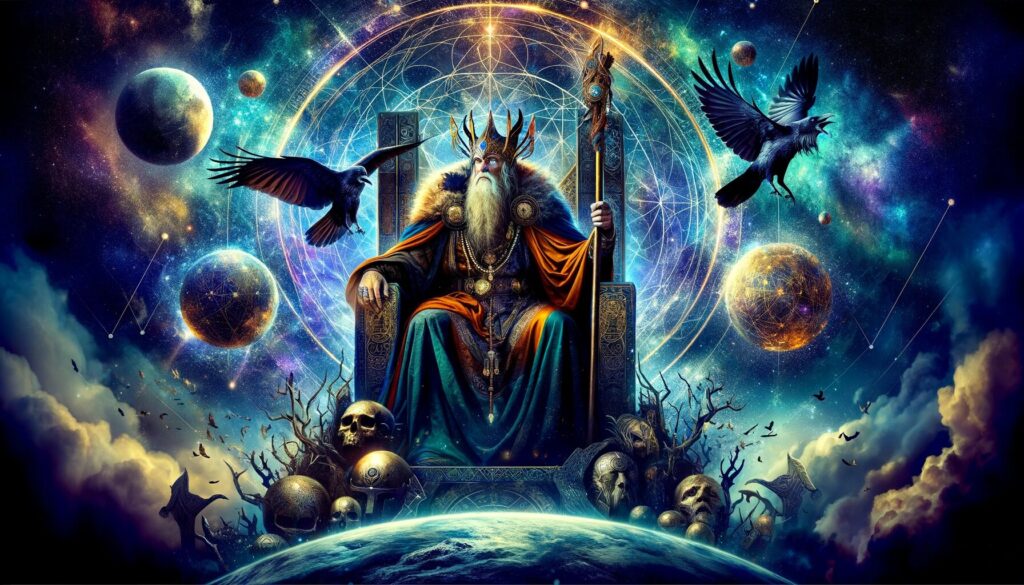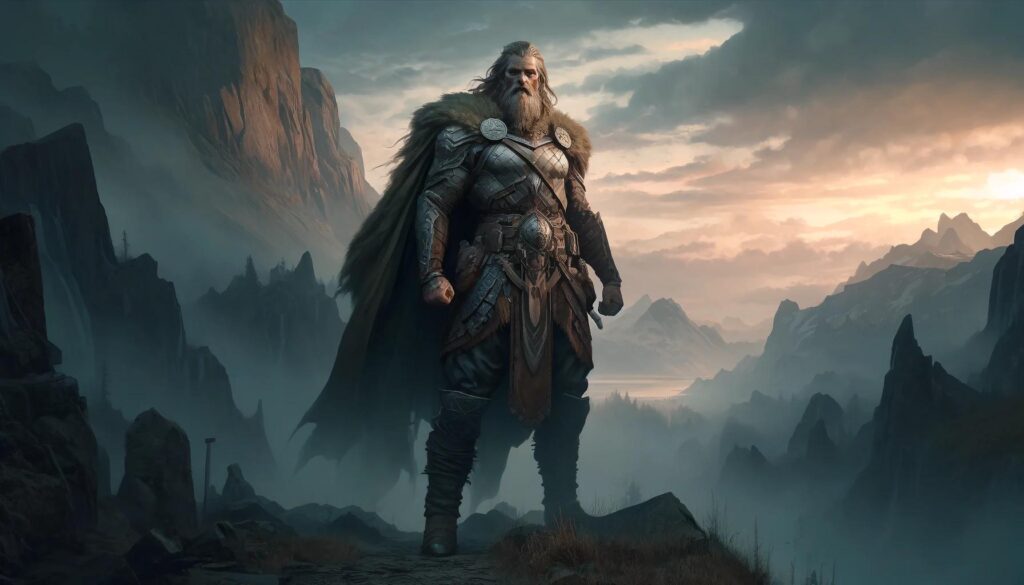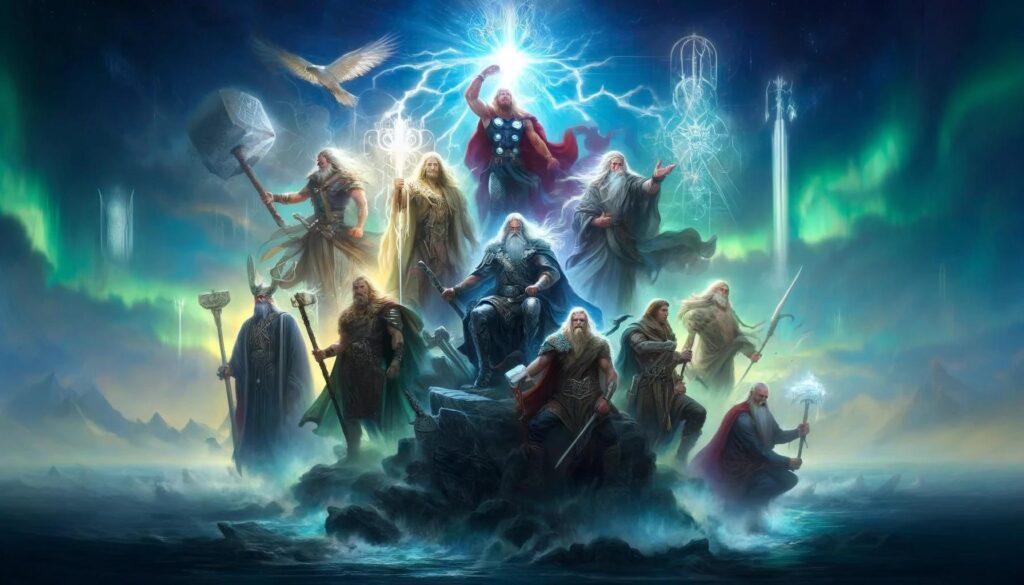Aesir Gods, Baldur, Heimdall, Loki, Norse Gods, Norse Mythology, Odin, Thor, Vali, Vidar
Odin’s Legacy: the Tales of His Many Sons
Welcome to a journey through the captivating world of Norse mythology, where the legendary Odin, the All-Father of the gods, reigns supreme. As we delve into the depths of Odin’s rich and complex legacy, we explore the fascinating stories of his many sons. From the mighty Thor to the cunning Loki, these Asgardian brothers carve their own mythic legacies, leaving an indelible mark on Norse mythology. So, who are Odin’s children? Keep reading this article to find out.
Who is Odin, and What is His Influence in Norse Mythology?
Role of Odin in Norse Mythology
In Norse mythology, Odin, also known as the All-Father, holds immense power and wisdom, revered as a god of war and poetry. He is the chief god of the Norse pantheon, associated with war, poetry, and wisdom, embodying the qualities of the Aesir. As the ruler of Asgard, the realm of the gods, Odin played a crucial role in the creation of the world and the establishment of order. All the gods and goddesses in Norse mythology revered and respected him.
Significance of Odin as All-Father
One of Odin’s most well-known attributes is his quest for wisdom. In his pursuit of knowledge, he sacrificed one of his eyes to gain knowledge of the runes. This act symbolizes his dedication to acquiring wisdom at any cost. As the All-Father, Odin serves as a nurturing figure and protector to his sons, including the god of war and the gods of Asgard. His wisdom and guidance shape the destinies of the gods and contribute to the overall mythology of Norse culture.

Odin’s Role in Ragnarok
Odin’s influence extends to the apocalyptic event known as Ragnarok. In this cataclysmic battle, Odin plays a significant part in the outcome. As the All-Father, he leads the gods of Asgard into battle against the forces of chaos and destruction. Odin’s actions and decisions during Ragnarok have far-reaching consequences for the fate of the gods and the world, underscoring his wisdom and leadership in Old English and Norse tales. His role in this event showcases the depth of his power and the impact he has on the Norse mythological narrative.
Odin’s Sons and Their Stories
In Norse mythology, Odin is known as the All-Father and has several sons who play significant roles in the tales and myths of the Norse gods. Each son possesses a distinct personality and contributes to the overall narrative of Asgard.
Thor: Odin’s Mighty Son and God of Thunder
Thor, the son of Odin, a powerful Norse god associated with thunder, stands as an enduring symbol of strength and protection within the Aesir. He is the protector of Asgard and wields the mighty hammer Mjolnir. Known for his immense strength and bravery, Thor often engages in epic battles against enemies of the gods.
Loki: The Trickster and Son of Odin
Although Loki is not Odin’s biological son, he is considered one of his sons due to their close relationship. Loki is a complex character and the trickster god of Norse mythology. He is associated with mischief, chaos, and cunning, attributes that often align with Loki’s complex role among the Aesir and Odin`s children in Norse mythology. Loki’s actions often lead to both advantageous and disastrous consequences for the gods.
Baldr: Odin’s Son and the God of Light
Baldr, the son of Odin and Frigg, is portrayed as a radiant and pure being who represents light and goodness among the Aesir. Gods and mortals love him for his kind nature and beauty. However, Baldr’s tragic death instigates a series of events that ultimately contribute to the cataclysmic battle of Ragnarok.
These are just a few examples of Odin’s sons and their stories in Norse mythology. Each son brings a unique perspective and adds depth to the rich tapestry of Asgardian siblings. The tales and myths surrounding Odin’s sons, including figures like Tyr, continue to captivate and inspire people, showcasing the enduring legacy of Norse gods in storytelling.
Other Notable Sons of Odin
In addition to Thor, Loki, and Baldr, Odin is also the father of other notable sons in Norse mythology. These sons, each with their own unique characteristics and roles, further contribute to the rich tapestry of Asgardian deities.
Heimdall: The Watchman and Son of Odin
One of Odin’s sons is Heimdall, known as the watchman of the gods. Heimdall possesses exceptional senses, allowing him to perceive any threat from miles away. He also guards the mythical Bifrost bridge, the pathway that connects Asgard to the other realms. As the eternal sentry, Heimdall exemplifies vigilance and protection.
Vidar: The Silent God and Odin’s Son
Another son of Odin is Vidar, often hailed as the silent god. Vidar is associated with strength and vengeance, and his quiet nature belies his immense power. In Norse mythology, Vidar plays a significant role in the aftermath of Ragnarok, the cataclysmic battle leading to the world’s rebirth, avenging Odin by defeating Fenrir. With his mighty strength, Vidar represents the unwavering resilience of the gods, destined to avenge Odin by slaying Fenrir during Ragnarok.

Vali: Son of Odin and God of Vengeance
Vali, born the son of Odin, is the god of vengeance among the children in Norse mythology. He was specifically brought into existence to avenge the death of his brother, Baldr. Vali embodies the pursuit of justice and retribution, seeking to right the wrongs committed against his family. As an Asgardian deity, Vali stands as a testament to the consequences that befall those who harm the gods, embodying the vengeance against Hodr for the slaying of Baldur.
Connections and Relationships Among Odin and His Sons
Odin’s Role as a Father and Protector
In Norse mythology, Odin’s relationships with his sons are deep-rooted and multifaceted. As a father, Odin plays a complex role in their lives, acting as both a nurturing figure and a distant presence. He shapes his sons’ destinies, guiding and protecting them from harm.
Odin’s role as a protector is vital. He watches over his sons and ensures their well-being. He is often involved in their journeys and adventures, lending his wisdom and support when needed, especially to his son Bragi, the god of poetry. His caring nature and fierce protection make him not only a father but also a guardian figure in their lives.
Interactions and Conflicts Among Odin’s Sons
The interactions among Odin’s sons are dynamic and filled with a mixture of camaraderie and conflict. Each son has a distinct personality, and their unique dynamics shape the narratives of Norse mythology.
One such example is the complex relationship between Thor and Loki. As brothers, their interactions range from friendship to enmity, creating a volatile and captivating dynamic. They often find themselves on opposite sides of conflicts, yet their destinies remain intertwined.
The sibling dynamics among Odin’s sons add depth and complexity to their stories. The conflicts and alliances that arise from their interactions showcase the complex tapestry of relationships within Norse mythology.
Bottom Line
The tales of Odin’s many sons in Norse mythology contribute to the deep and intricate narrative of the gods and their struggles. Each son, from the mighty Thor to the cunning Loki, brings a unique perspective and adds to the mythic tapestry of Asgard.
These stories have endured, captivating and inspiring people for generations. They showcase the enduring power of Norse mythology, igniting our imagination and reminding us of the rich legacy left by Odin and his sons.
Exploring the adventures and challenges faced by Odin’s sons allows us to delve into the complexities of the Asgardian siblings, revealing their strengths, weaknesses, and the intricate dynamics of their relationships. From Thor’s thunderous might to Loki’s mischievous cunning, each son brings a distinct flavor to the mythology, enriching our understanding of the Norse pantheon.
Whether we are fascinated by tales of heroism, intrigued by tales of trickery, or moved by tales of sacrifice, the stories of Odin’s sons in Norse mythology continue to resonate with audiences worldwide. They are a testament to the enduring power of mythic tales and their ability to captivate and inspire across cultures and generations.

